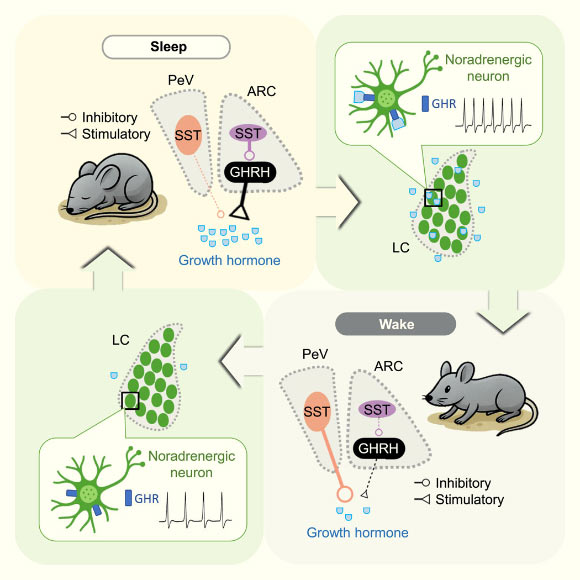Now Reading: Study Reveals Link Between Sleep and Growth Hormone Regulation
-
01
Study Reveals Link Between Sleep and Growth Hormone Regulation
Study Reveals Link Between Sleep and Growth Hormone Regulation

Quick Summary
- Neuroscientists from UC Berkeley and Stanford University have identified brain circuits regulating growth hormone release during REM and non-REM sleep.
- Growth hormone release is managed by hypothalamic neurons: GHRH (promotes release) and somatostatin (inhibits release), showing distinct behavior in different sleep phases.
– Strong surges of both occur in REM; moderate GHRH rise but decreased somatostatin occurs in non-REM sleep.
- Growth hormone enhances activity in locus coeruleus neurons, impacting arousal, attention, cognition, and balancing wakefulness/sleep cycles via a negative feedback loop.
- Dysregulation of this relationship is linked to neurological disorders such as Parkinson’s or Alzheimer’s disease; potential therapeutic pathways suggested include hormonal or gene therapies targeting these circuits.
- The study used advanced techniques such as light stimulation and circuit tracing on mice due to their segmented sleep-wake patterns.
Image:
!Neural Mechanisms for Sleep & Growth Hormone Regulation
The research findings could inform new treatments for metabolic disorders like diabetes or degenerative conditions.
indian opinion Analysis
The discovery of neural circuits controlling growth hormone release connected with sleep has significant medical implications. for India, its relevance spans various domains. First, with rising instances of metabolic illnesses like diabetes – projected to affect over 101 million Indians by 2030 – understanding how hormonal balance interacts with sleep offers hope for targeted interventions. Similarly, neurodegenerative diseases are growing concerns globally as life expectancy rises; innovations stemming from these mechanisms could help alleviate related burdens on India’s healthcare system.
If developed further into practical treatments via hormonal therapies or gene-editing techniques mentioned by researchers, affordability remains vital for adoption within India’s diverse socio-economic landscape. This study emphasizes the role of balanced physiological systems (e.g., locus coeruleus/neuron regulation), pinpointing avenues beyond conventional approaches to ensure broader mental wellness outcomes.

























